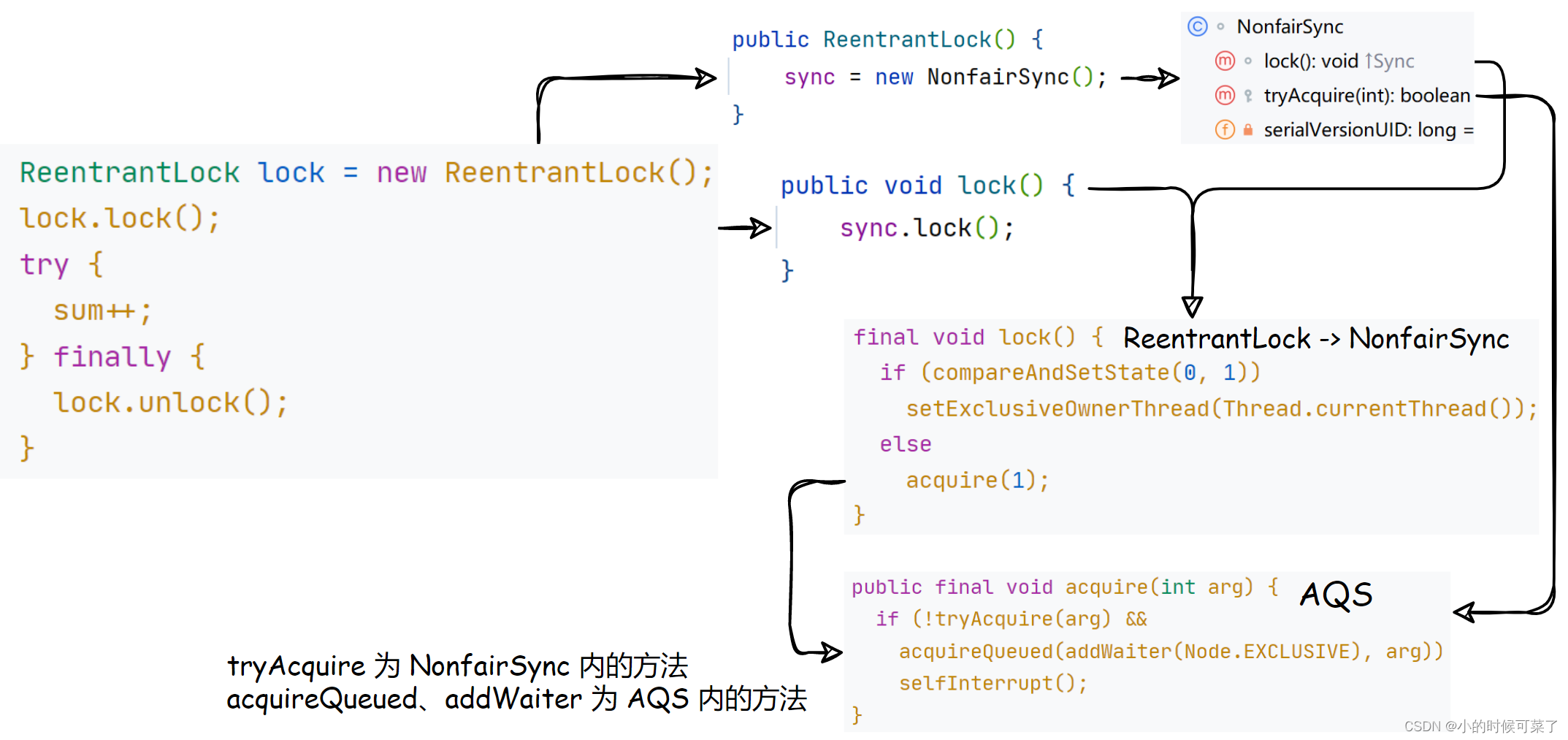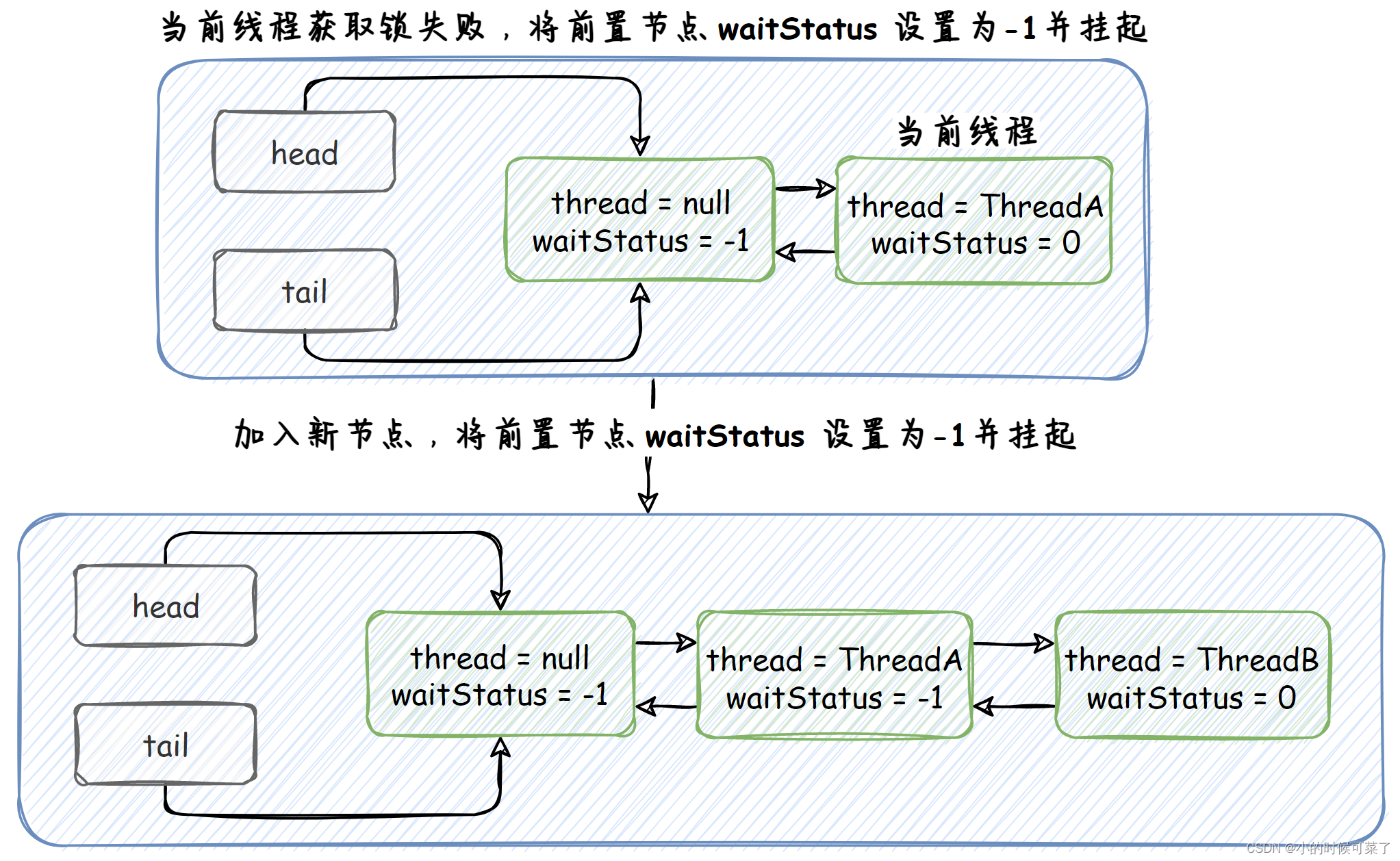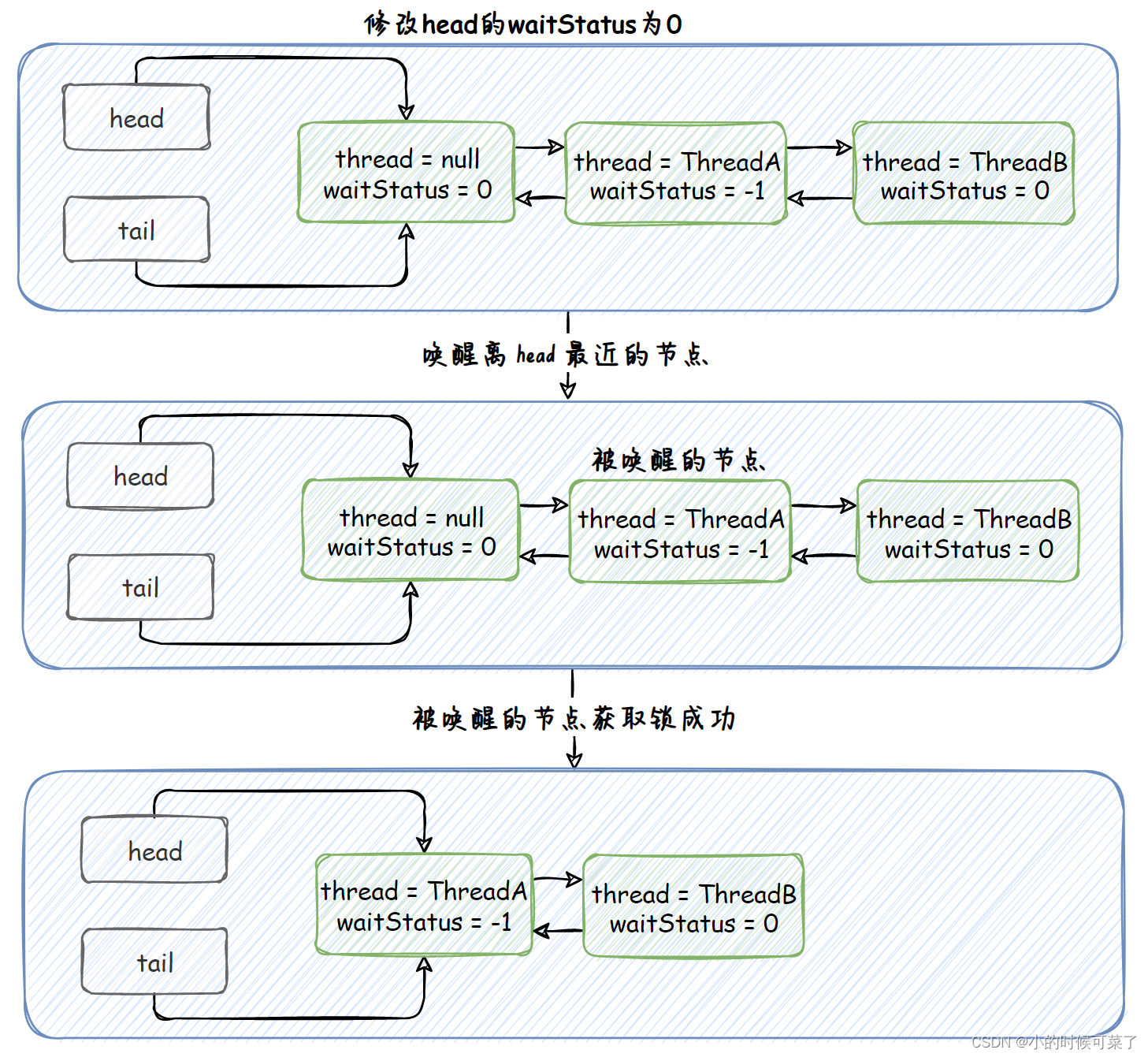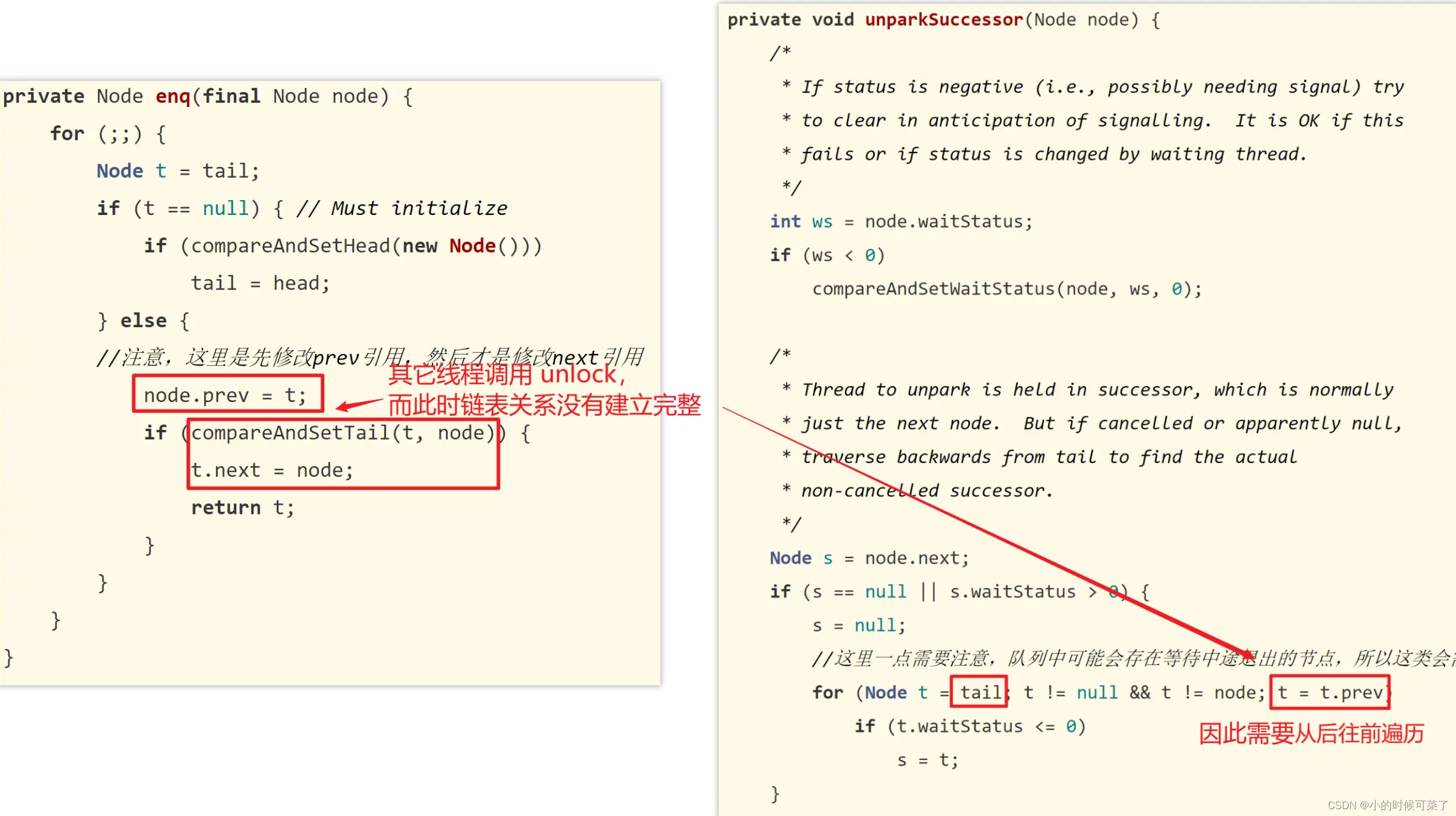多线程情况下,sum++,因线程切换导致并发问题,因此需给导致并发问题的代码加锁
使用 synchronized 方式
public class MultiThreadAddDemo {
static int sum;
public static void main(String[] args) throws InterruptedException {
Thread[] threads = new Thread[2];
for (int i = 0; i < 2; i++) {
threads[i] = new Thread(() -> {
for (int j = 0; j < 10000; j++) {
synchronized (MultiThreadAddDemo.class) {
sum++;
}
}
});
threads[i].start();
}
threads[0].join();
threads[1].join();
System.out.println(sum);
}
}
synchronized 为悲观锁,它是一种思想,即认为如果不给资源加锁,则一定会发生错误,所以其加锁方式是重量级的
而乐观锁与之相反,它是一种无锁的加锁方式,ReentrantLock 就是其中一种
使用 ReentrantLock 方式
public class MultiThreadAddDemo {
static int sum = 0;
public static void main(String[] args) throws InterruptedException {
Thread[] threads = new Thread[2];
ReentrantLock lock = new ReentrantLock();
for (int i = 0; i < 2; i++) {
threads[i] = new Thread(() -> {
for (int j = 0; j < 10000; j++) {
lock.lock();
try {
sum++;
} finally {
lock.unlock();
}
}
});
threads[i].start();
}
threads[0].join();
threads[1].join();
System.out.println(MultiThreadAddDemo.sum);
}
}
上述代码中使用到了 new ReentrantLock() 、lock.lock()

ReentrantLock 继承关系大致如下
class ReentrantLock implements Lock {
class NonfairSync extends Sync { }
class Sync extends AbstractQueuedSynchronizer { }
}
class AbstractQueuedSynchronizer extends AbstractOwnableSynchronizer { }
AbstractQueuedSynchronizer,简称 AQS,其继承 AbstractOwnableSynchronizer,
AbstractOwnableSynchronizer中有个 exclusiveOwnerThread 字段,记录那个线程持有当前独占锁,尝试获取资源(tryAcquire)时会用到
public abstract class AbstractOwnableSynchronizer implements java.io.Serializable {
private static final long serialVersionUID = 3737899427754241961L;
/**
* The current owner of exclusive mode synchronization. 记录那个线程持有当前独占锁
*/
private transient Thread exclusiveOwnerThread;
// exclusiveOwnerThread 的 setter、getter
}
AQS 内部有个 state 字段,尝试获取资源(tryAcquire)时会用到;以及一个双向链表,用于存储修改 state 失败的线程
先来看看 AQS 中的两个模板方法,继承 AQS 需实现该方法,否则使用该方法会抛出异常
protected boolean tryAcquire(int arg) { // <----- 独占方式:尝试获取资源
throw new UnsupportedOperationException();
}
protected boolean tryRelease(int arg) { // <----- 独占方式:尝试释放资源
throw new UnsupportedOperationException();
}
NonfairSync - lock 逻辑
public class ReentrantLock implements Lock, java.io.Serializable {
public ReentrantLock() {
sync = new NonfairSync();
}
public void lock() {
sync.lock();
}
static final class NonfairSync extends Sync {
private static final long serialVersionUID = 7316153563782823691L;
final void lock() {
if (compareAndSetState(0, 1)) // <----- 通过 CAS 检查锁资源(不会检测 AQS 队列)
setExclusiveOwnerThread(Thread.currentThread()); // <----- 设置 exclusiveOwnerThread(AbstractOwnableSynchronizer 类中除序列化字段外唯一字段)
else // <----- 获取锁失败
acquire(1); // <----- 调用 AQS 中的 acquire、表示尝试获取锁(独占锁)
}
/** AQS 中的 acquire 方法
public final void acquire(int arg) {
if (!tryAcquire(arg) && // <----- tryAcquire 为模板方法,调用子类实现的 tryAcquire,及下面的代码
acquireQueued(addWaiter(Node.EXCLUSIVE), arg))
selfInterrupt();
}
*/
protected final boolean tryAcquire(int acquires) { // <----- NonfairSync 中实现了 tryAcquire 方法,尝试获取资源(独占方式)
return nonfairTryAcquire(acquires); // <----- Sync 中的 nonfairTryAcquire,大致逻辑,根据 AQS 中的 state,设置 exclusiveOwnerThread
}
}
tryAcquire 获取独占锁
tryAcquire(1)一下,名字上就知道,这个只是试一试
通过 AQS 中的 state,可以知道当前的锁是否存在线程
-
为 0,表示无锁,设置 exclusiveOwnerThread
-
不为0:判断
当前锁线程是否与当前线程相等- 相等:增加重入次数
setState(getState() + acquires)( 根据acquire(1)可以知道,acquires 参数为 1) - 不相等:返回 false,表示尝试获取锁失败
- 相等:增加重入次数
final boolean nonfairTryAcquire(int acquires) {
final Thread current = Thread.currentThread();
int c = getState();
if (c == 0) {
if (compareAndSetState(0, acquires)) {
setExclusiveOwnerThread(current);
return true;
}
} else if (current == getExclusiveOwnerThread()) {
int nextc = c + acquires;
if (nextc < 0) // overflow
throw new Error("Maximum lock count exceeded");
setState(nextc);
return true;
}
return false;
}
addWaiter - 添加 Node 到 AQS 队列
AQS 内维护了一个双向链表,用于存储修改 state 失败的线程
尝试获取锁失败,则会执行 addWaiter及 acquireQueued(addWaiter(Node.EXCLUSIVE), arg))
public abstract class AbstractQueuedSynchronizer extends AbstractOwnableSynchronizer implements java.io.Serializable {
public final void acquire(int arg) {
if (!tryAcquire(arg) &&
acquireQueued(addWaiter(Node.EXCLUSIVE), arg))
selfInterrupt();
}
private Node addWaiter(Node mode) {
Node node = new Node(Thread.currentThread(), mode);
// Try the fast path of enq; backup to full enq on failure
Node pred = tail;
if (pred != null) { // <----- 队列不为空,插入并返回节点
node.prev = pred; // <----- 与队列中最后一个节点进行关联
if (compareAndSetTail(pred, node)) {
pred.next = node;
return node;
}
}
enq(node); // <----- 队列为空
return node;
}
private Node enq(final Node node) {
for (; ; ) {
Node t = tail;
if (t == null) { // Must initialize
// 创建 head(初始节点):初始节点为 Dummy(哑元或哨兵),用来占位,并不关联线程,因此 thread 为 null
// compareAndSetHead -> unsafe.compareAndSwapObject(this, headOffset, null, update);
if (compareAndSetHead(new Node())) // <----- 设置传入对象的 headOffset 位置的值,即 head 的值
tail = head; // <----- 将 head 赋值给 tail 之后,进入第二次的 for 循环
} else {
node.prev = t; // <----- 与 tail 进行关联
if (compareAndSetTail(t, node)) {
t.next = node; // <----- tail 的 next 指向当前节点
return t;
}
}
}
}
}
第一次会进入 enq,创建一个 Dummy,之后将当前节点加入到 Dummy 之后

acquireQueued
public abstract class AbstractQueuedSynchronizer extends AbstractOwnableSynchronizer implements java.io.Serializable {
public final void acquire(int arg) {
if (!tryAcquire(arg) &&
acquireQueued(addWaiter(Node.EXCLUSIVE), arg))
selfInterrupt();
}
private Node addWaiter(Node mode) {
// ......
}
private Node enq(final Node node) {
// ......
}
final boolean acquireQueued(final Node node, int arg) {
boolean failed = true;
try {
boolean interrupted = false;
for (;;) {
// 通过头节点去判断当前节点是否有资格获取锁
final Node p = node.predecessor();
if (p == head && tryAcquire(arg)) { // <----- 前置节点为 head,则再次尝试获取锁
setHead(node);
p.next = null; // help GC
failed = false;
return interrupted;
}
// 前置节点不为 head,或 tryAcquire(尝试获取锁)失败
if (shouldParkAfterFailedAcquire(p, node) && // <----- 根据节点状态,决定当前线程是否应被挂起?
parkAndCheckInterrupt()) // <----- 调用 park 方法挂起当前线程,等待以后被唤醒
interrupted = true; // <----- 重新设置中断标记:interrupted 会清除中断标记
}
} finally {
// try 执行结果的 failed 永远是 false,只有抛出异常,才会进入
if (failed)
// 将 Node 的 waitStatus 置为 CANCEL
cancelAcquire(node);
}
}
private final boolean parkAndCheckInterrupt() {
LockSupport.park(this);
// 当前线程在这里阻塞
// 如果其他线程调用了该线程的 interrupt 方法(使用 park ,调用 interrupt 时不会抛出异常,只会改变中断状态值),于是需通过一个变量记录该值
// 返回 true,将中断标记传到外层,使得获取锁成功时,acquireQueued 返回值为 interrupted 的状态
return Thread.interrupted();
}
}
shouldParkAfterFailedAcquire - 修改节点状态
Node 有 5 中状态,默认为 0
static final class Node {
/** waitStatus value to indicate thread has cancelled */
static final int CANCELLED = 1;
/** waitStatus value to indicate successor's thread needs unparking */
static final int SIGNAL = -1;
/** waitStatus value to indicate thread is waiting on condition */
static final int CONDITION = -2;
/**
* waitStatus value to indicate the next acquireShared should
* unconditionally propagate
*/
static final int PROPAGATE = -3;
}
shouldParkAfterFailedAcquire 函数会确保在同步队列中,每个等待的线程状态都是正常的
每个 node 在入队的时候,都会将其前置节点的状态改为 SIGNAL,然后阻塞,等待被前置唤醒
private static boolean shouldParkAfterFailedAcquire(Node pred, Node node) {
int ws = pred.waitStatus;
if (ws == Node.SIGNAL)
/*
* This node has already set status asking a release
* to signal it, so it can safely park.
* 当前节点前置节点为 SIGNAL,说明前置节点也在等待拿锁,所以当前节点可以挂起休息
* SIGNAL 表示:只要释放锁,就有责任通知标志位为 SIGNAL 的后继节点(进入阻塞队列排队的线程会被挂起,而唤醒的操作是由前置节点完成的)
*/
return true;
if (ws > 0) {
/*
* Predecessor was cancelled. Skip over predecessors and
* indicate retry.
* 状态只可能是 CANCEL
* 前置节点取消了排队,需移除当前前置节点,然后一直向前寻找,直到找到前置节点 pred.waitStatus > 0
*/
do {
node.prev = pred = pred.prev;
} while (pred.waitStatus > 0);
pred.next = node;
} else {
/*
* waitStatus must be 0 or PROPAGATE. Indicate that we
* need a signal, but don't park yet. Caller will need to
* retry to make sure it cannot acquire before parking.
* waitStatus 只可能是0,-2,-3
* 用 CAS 将前置节点的 waitStatus 设置为 Node.SIGNAL(也就是-1)
* !!!第一次进来的时候,waitStatus 为默认值 0,于是设置当前 pred 为 -1
* 之后会通过 acquireQueued 内的 for 循环,第二次进入,waitStatus 为 -1,返回 true,调用 parkAndCheckInterrupt 进行阻塞
*/
compareAndSetWaitStatus(pred, ws, Node.SIGNAL);
}
return false;
}
通过对 acquireQueued 分析,可以得出
- 如果当前节点为
head 后一个节点:尝试获取锁,失败挂起 - 如果当前节点不为
head 后一个节点:刚加入时的 waitStatus 为 0,之后在 shouldParkAfterFailedAcquire 方法内变为 -1,然后经过 parkAndCheckInterrupt 方法挂起
也就是说,只有在 head 节点之后的节点可以通过 CAS 获取锁

其他线程何时被唤醒?
猜想:当一个线程使用完共享资源,并且要释放锁的时候,去唤醒其他正在等待锁的线程
释放锁
public class ReentrantLock implements Lock, java.io.Serializable {
public void unlock() {
sync.release(1); // <----- 调用 AQS 中的 release
}
abstract static class Sync extends AbstractQueuedSynchronizer {
protected final boolean tryRelease(int releases) { // <----- 根据 state,设置 exclusiveOwnerThread
int c = getState() - releases;
if (Thread.currentThread() != getExclusiveOwnerThread())
throw new IllegalMonitorStateException();
boolean free = false;
if (c == 0) {
free = true;
setExclusiveOwnerThread(null);
}
setState(c);
return free;
}
}
}
public abstract class AbstractQueuedSynchronizer extends AbstractOwnableSynchronizer implements java.io.Serializable {
public final boolean release(int arg) {
if (tryRelease(arg)) {
Node h = head;
if (h != null && h.waitStatus != 0)
unparkSuccessor(h);
return true;
}
return false;
}
private void unparkSuccessor(AbstractQueuedSynchronizer.Node node) {
/*
* If status is negative (i.e., possibly needing signal) try
* to clear in anticipation of signalling. It is OK if this
* fails or if status is changed by waiting thread.
*/
int ws = node.waitStatus;
if (ws < 0)
compareAndSetWaitStatus(node, ws, 0);
/*
* Thread to unpark is held in successor, which is normally
* just the next node. But if cancelled or apparently null,
* traverse backwards from tail to find the actual
* non-cancelled successor.
*/
AbstractQueuedSynchronizer.Node s = node.next;
// 如果 head 下一个节点为 null,或者 waitStatus 为 -1(表示 CANCELLED:线程取消了排队)
// 从队列 tail 开始,从后往前遍历,找到离 head 最近的 waitStatus <= 0 节点(不是最近,会被覆盖)
if (s == null || s.waitStatus > 0) {
s = null;
for (AbstractQueuedSynchronizer.Node t = tail; t != null && t != node; t = t.prev)
if (t.waitStatus <= 0)
s = t;
}
if (s != null)
LockSupport.unpark(s.thread);
}
}
当释放锁时,将 head 的 waitStatus 设置为 0,避免影响其他函数的判断
并且从队列 tail 开始,从后往前遍历,找到离 head 最近的 waitStatus <= 0 节点,然后调用 unpark
被唤醒的节点获取锁成功,则将当前节点设为 head

唤醒时为何从后往前遍历
当 enq 一个新的节点的时候, 会使新节点的 prev 等于 tail:node.prev = t;
然后通过 CAS,使 tail.next = 新节点:if (compareAndSetTail(t, node)) { t.next = node; }
如果在 CAS 操作之后,t.next = node 还未执行到时,其他线程调用 unlock(),而链表关系没有建立完整,如果从前往后遍历,导致遍历失败

参考资料及推荐阅读
- B站视频 -【Java并发】并发编程的意义是什么?
- https://javadoop.com/post/AbstractQueuedSynchronizer
- https://javaguide.cn/java/concurrent/aqs.html
- Java 并发编程(Mic)






















 4309
4309











 被折叠的 条评论
为什么被折叠?
被折叠的 条评论
为什么被折叠?








